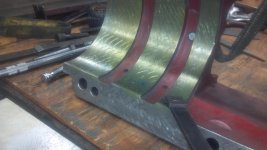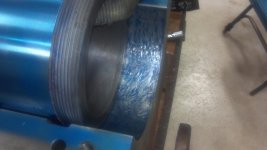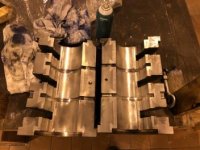Hello all,
I’ve been a long time reader and finally decided to take the plunge and post.
Some background on me, I began my career as a machinist (manual and basic CNC) and spent 5 years in the trade....barely scratched the surface?!?? I then had the opportunity to apprentice as a millwright, and have been doing that ever since (16 years give or take).
I’ve encountered an issue scraping a babbit bearing on a horizontal split pump. These pumps date back to the early 1950s, the impeller Diameter is 48” pumping roughly 26 million imperial gallons per day.
Shaft size at the bearings is 6.5” (+/-). The bearing housings are not cast as part of the pump housing, they are doweled and bolted in place. I’ve verified their location and all seems good. For thrust, the outboard bearing is designed with 3 collars, spread out axially roughly every 3” over the bearing area. The bearing has babbit cast to accommodate these collars, collars and groove are roughly .375” larger than the shaft diameter. Total thrust clearance according to the pump manual is .025”.
Post machining I verified the babbit dimensions and all was within spec, engineers on this are hoping to achieve somewhere in the neighbourhood of a .004” oil wedge.
Although the bearing housing is split horizontally (“standard”), the bearing itself is fit into the housing with the split in the vertical position. This is where I’ve encountered issues, rolling the bearing in and out while bluing yields many false bluing readings (smears).
My process-
-Lightly blue shaft
-use hydraulic jack to lift shaft
-roll in one bearing half (naturally it settles at the bottom half of the housing)
-drop second bearing half onto first half (ensure locating dowels for bearings halves are “engaged”)
-roll entire assembly into place so that bearing split is in vertical position
-release hyd jacks (lower shaft)
-rotate shaft repeatedly
-raise shaft using jacks
-rotate bearings in housing until split is horizontal
-remove first half
-remove second half
When looking at the blue transfer the bearing has smear marks along much of this surface area. I say smear marks because they aren’t high spots as would be expected.
My idea to solve this was was to remove the shaft/impeller from the housing (using crane) and chain falls to ensure assembly lifts slowly and level. Once removed, blue shaft, install bearings halves with split vertical. Use long hose clamps to keep bearing halves on shaft (apply just enough pressure to keep halves together). Reinstall shaft/impeller in housing, and release hose clamp. Rotate shaft for blue transfer, reinstall hose clamps, and pull shaft/impeller assembly.
Does this make any sense?
Have I completely missed something in regards to getting readings that can the trusted?
With a lot of work on ball mills and pumps I’ve been lucky enough to have been involved in bearing scraping since I started in the trade, however I’ve never had to scrape anything with the split in the vertical position that required so much rolling about the shaft.
Any help is greatly appreciated,
Thanks,
Peter
I’ve been a long time reader and finally decided to take the plunge and post.
Some background on me, I began my career as a machinist (manual and basic CNC) and spent 5 years in the trade....barely scratched the surface?!?? I then had the opportunity to apprentice as a millwright, and have been doing that ever since (16 years give or take).
I’ve encountered an issue scraping a babbit bearing on a horizontal split pump. These pumps date back to the early 1950s, the impeller Diameter is 48” pumping roughly 26 million imperial gallons per day.
Shaft size at the bearings is 6.5” (+/-). The bearing housings are not cast as part of the pump housing, they are doweled and bolted in place. I’ve verified their location and all seems good. For thrust, the outboard bearing is designed with 3 collars, spread out axially roughly every 3” over the bearing area. The bearing has babbit cast to accommodate these collars, collars and groove are roughly .375” larger than the shaft diameter. Total thrust clearance according to the pump manual is .025”.
Post machining I verified the babbit dimensions and all was within spec, engineers on this are hoping to achieve somewhere in the neighbourhood of a .004” oil wedge.
Although the bearing housing is split horizontally (“standard”), the bearing itself is fit into the housing with the split in the vertical position. This is where I’ve encountered issues, rolling the bearing in and out while bluing yields many false bluing readings (smears).
My process-
-Lightly blue shaft
-use hydraulic jack to lift shaft
-roll in one bearing half (naturally it settles at the bottom half of the housing)
-drop second bearing half onto first half (ensure locating dowels for bearings halves are “engaged”)
-roll entire assembly into place so that bearing split is in vertical position
-release hyd jacks (lower shaft)
-rotate shaft repeatedly
-raise shaft using jacks
-rotate bearings in housing until split is horizontal
-remove first half
-remove second half
When looking at the blue transfer the bearing has smear marks along much of this surface area. I say smear marks because they aren’t high spots as would be expected.
My idea to solve this was was to remove the shaft/impeller from the housing (using crane) and chain falls to ensure assembly lifts slowly and level. Once removed, blue shaft, install bearings halves with split vertical. Use long hose clamps to keep bearing halves on shaft (apply just enough pressure to keep halves together). Reinstall shaft/impeller in housing, and release hose clamp. Rotate shaft for blue transfer, reinstall hose clamps, and pull shaft/impeller assembly.
Does this make any sense?
Have I completely missed something in regards to getting readings that can the trusted?
With a lot of work on ball mills and pumps I’ve been lucky enough to have been involved in bearing scraping since I started in the trade, however I’ve never had to scrape anything with the split in the vertical position that required so much rolling about the shaft.
Any help is greatly appreciated,
Thanks,
Peter









